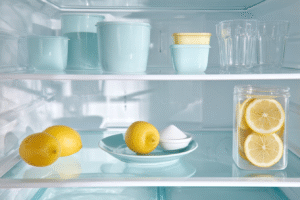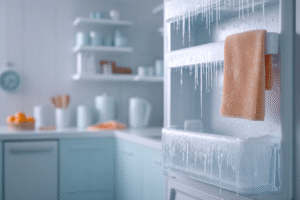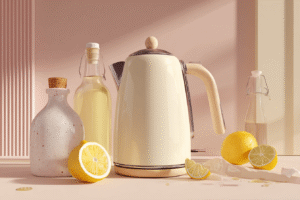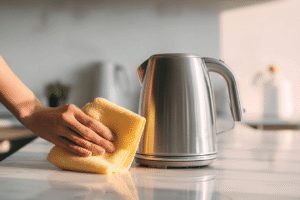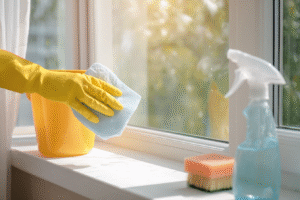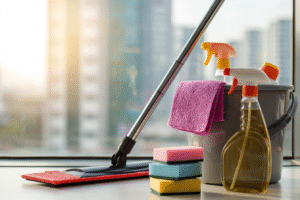Summarise this article with:
When your dishwasher stops doing its job properly, dirty dishes and food residue can quickly turn your kitchen routine upside down. We understand how frustrating this can be – you load everything in expecting sparkling results, only to find greasy plates and grimy glasses staring back at you.
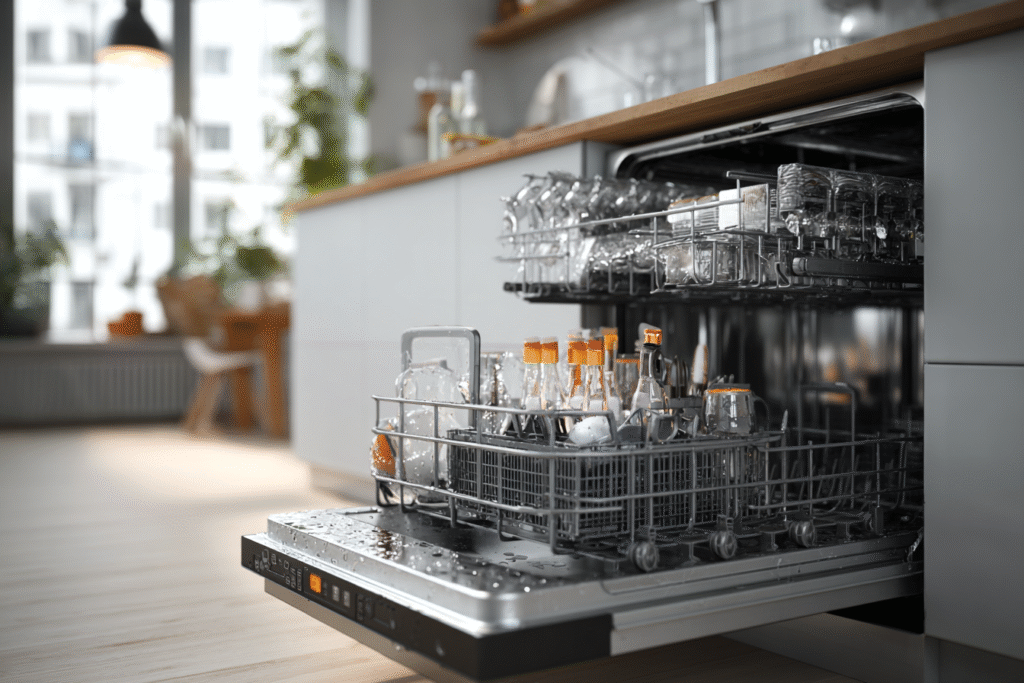
Why Is My Dishwasher Not Cleaning Properly?
Dirty Filter Blocking Water Flow
Your dishwasher filter sits quietly at the bottom of your appliance, catching food particles and debris before they can recirculate onto your clean dishes. Over time, this hardworking component becomes clogged with everything from pasta remnants to soap scum, creating a blockage that severely impacts water flow.
Here’s what happens: when the filter gets dirty, your dishwasher starts recirculating grimy water instead of fresh, clean water. The result? Dishes that come out looking worse than when they went in.
The fix is straightforward. Remove the filter (usually by twisting it anticlockwise), rinse it under warm water, and give it a gentle scrub with a small brush. For stubborn buildup, soak it in warm, soapy water for a few minutes. We recommend checking your instruction manual for your specific model’s filter location and removal process. For a step-by-step guide to thoroughly cleaning the filter, refer to How to Clean Your Dishwasher Filter.
At Wecasa, our professional cleaners know that regular filter maintenance is the difference between sparkling dishes and disappointing results.
Clogged Spray Arms Can’t Reach Your Dishes
When spray arms become blocked with food particles or mineral deposits, they simply can’t distribute water effectively across your dishes. You’ll notice this problem most on cups and utensils that come out still grimy despite a full wash cycle.
Check for blockages by removing the spray arms – most twist off easily or lift straight up. Look for hard water buildup around the jets and small holes. Food debris often gets trapped here, creating a common issue that stops proper water circulation.
Clean them thoroughly using a cocktail stick to clear individual holes, then rinse under warm water. For stubborn mineral deposits, soak the arms in cups of white vinegar for 30 minutes. This simple maintenance task can transform your dishwasher’s effective cleaning results immediately.
Once reassembled, run an empty cycle to test the water flow reaches all areas of your basket of the dishwasher.
Detergent Issues and Tablet Not Dissolving
Dishwasher tablets need hot water and proper water flow to dissolve completely. If your detergent dispenser door can’t open fully because pans or large items block it, the tablet stays trapped and your dishes won’t get clean.
Check that nothing prevents the dispenser from opening during the cycle. Remove any blockage across the nozzles of your spray arms using a cocktail stick – food debris here stops water reaching the detergent compartment effectively.
Water temperature matters too. Your inlet valve should deliver water at least 120 degrees Fahrenheit for tablets to dissolve properly. Run your kitchen tap until steaming hot before starting a cycle, or select a higher temperature setting if available.
We recommend checking your information about the programme settings – short, cool cycles don’t give tablets enough time to work. At Wecasa, our cleaning professionals know that main reasons for poor dissolving include blocked dispensers and insufficient heat.
Step-by-Step Fixes for Poor Dishwasher Performance
How to Clean a Dishwasher Filter
Most dishwashers hide their filter at the bottom of the tub, usually beneath the bottom spray arm. You’ll typically find a cylindrical component that twists out anticlockwise – this catches the dirt and food particles before they can cause problems.
Remove the filter carefully and rinse under warm running water to clear away trapped debris. For stubborn buildup, use a soft brush with washing-up liquid to gently scrub the mesh sections. Never use wire brushes or scouring pads as these can damage the delicate filter material.
The space available around the filter often collects additional grime, so take a moment to wipe down this area too. Once everything’s clean and dry, reinstall by twisting clockwise until it locks securely in place.
This monthly maintenance prevents cause of a dishwasher not cleaning effectively and keeps your appliance running smoothly. A clean filter means better water flow and genuinely spotless results every time and we have a detailed guide on cleaning your dishwasher’s filter.
How to Unblock Dishwasher Spray Arms
Start by removing both spray arms from your appliance – they typically lift off or unscrew with a quarter turn. You’ll spot the dirt and food particles blocking the small holes immediately.
Soak the arms in warm water mixed with cups of white vinegar for thirty minutes. This dissolves stubborn mineral deposits that cases the dirt to stick. Use a cocktail stick to gently clear each hole, working from both sides to push debris through completely.
Rinse thoroughly under running water, shaking each arm to remove loosened parts of the items trapped inside. For persistent blockages, a soft brush helps dislodge stubborn buildup without damaging the delicate spray holes.
Once reinstalled, your dishwasher will distribute water evenly again, reaching every corner of your dishes. At Wecasa, we know this simple fix transforms disappointing wash results into sparkling success every time.
Checking Water Temperature and Pressure
Water temperature below 120°F prevents detergent from dissolving effectively and leaves food particles clinging to your dishes. Your dishwasher relies on hot water to break down grease and activate cleaning agents properly.
Run your kitchen tap until steaming before starting any cycle – this clears cold water from the pipes and ensures your appliance fills with adequately heated water. Water pressure between 20-120 PSI is needed for spray arms to function correctly.
Low pressure reduces the force needed to dislodge stubborn food remnants and prevents proper water circulation. Check your home’s main water valve is fully open, and inspect supply lines for kinks or blockages that restrict flow.
If pressure issues persist throughout your home, you may need professional assistance to address broader plumbing concerns affecting your dishwasher’s performance.
Why Are My Dishes Still Dirty After Washing?
Improper Loading Blocks Water Circulation
Think your dishwasher’s playing favourites with certain dishes? The culprit is likely how you’re loading it. When plates overlap or face the wrong direction, water simply can’t reach every surface effectively.
Face dirty surfaces towards the centre where spray arms work hardest. Bowls and cups need angling downwards so water doesn’t pool inside, and large items shouldn’t block smaller ones behind them.
Leave breathing room between items – cramming everything in might save time, but it blocks water circulation completely. Your spray arms need clear paths to rotate freely, reaching every corner of your load.
If the upper rack is not receiving enough water flow, see our article Dishwasher Not Cleaning Top Rack for targeted solutions.
Wecasa’s cleaning professionals see this mistake constantly. Proper spacing transforms mediocre results into genuinely spotless dishes every single time.
Wrong Detergent or Rinse Aid Issues
Using too much or too little detergent creates films and residues that make dishes appear dirty even after washing. Check your detergent amount – tablets work best in most modern machines, but powder gives you control over quantity for different load sizes.
Rinse aid isn’t optional despite what many believe. Without it, water clings to dishes leaving spots and streaks, particularly on glassware. Fill the dispenser monthly and adjust the setting if you notice rainbow streaks (too much) or persistent water marks (too little).
Old or expired detergent loses effectiveness over time. Store powder in cool, dry conditions and replace if it’s clumped together. Wrong water temperature also prevents proper dissolving – your dishwasher cleaner needs hot water to activate properly.
If you’re still struggling with these issues, a person experienced in appliance maintenance can assess whether your dispenser mechanism needs attention or replacement, or you can see our guide on cleaning your dishwasher.
Hard Water Leaving Gritty Residue
Hard water contains high levels of calcium and magnesium that create chalky deposits on everything your dishwasher touches. When heated during the wash cycle, these minerals concentrate and leave behind that unmistakable gritty film on dishes and glassware.
White vinegar breaks down mineral buildup naturally – place two cups in a dishwasher-safe bowl on the top rack and run a hot cycle monthly. Rinse aid prevents water droplets from clinging to surfaces, reducing those stubborn white spots that make clean dishes look dirty.
Citric acid works brilliantly for stubborn deposits. Sprinkle a cup on the bottom of your empty dishwasher and run a full hot cycle to dissolve accumulated scale from internal components and spray arms.
The key is consistent maintenance rather than hoping the problem disappears. Regular descaling keeps your appliance performing optimally while protecting your investment from mineral damage.
Brand-Specific Troubleshooting Solutions
Bosch and Neff Dishwasher Common Issues
Bosch and Neff dishwashers share similar engineering, which means they often develop identical faults over time. The most frequent complaint involves spray arms losing rotation power – you’ll hear the usual water sounds, but dishes emerge disappointingly dirty.
Check if your spray arms actually spin by opening the door mid-cycle. If they’re stationary despite water flow, the pivot points have worn out and need replacement. This typically happens after 5-7 years of regular use.
Blocked side chamber pipes cause another common issue where water circulates but cleaning power drops dramatically. Food debris accumulates in the connection between the side chamber and main sump, requiring professional attention to access and clear properly.
Samsung and Hotpoint Cleaning Problems
Samsung and Hotpoint owners often face frustrating detergent dispenser failures where tablets remain undissolved after complete cycles. The spring mechanism becomes sticky over time, preventing proper opening during the wash phase.
Run your kitchen tap until steaming hot before starting any cycle – both brands rely heavily on immediate hot water contact for optimal performance. Cold water start-up leaves residue and poor dissolving every single time.
Water inlet valve issues plague these models particularly. If your machine sounds like it’s filling but dishes emerge dirty, the valve isn’t allowing sufficient water volume through. This creates weak spray pressure that looks normal but lacks the force needed for proper cleaning.
What sets these brands apart? Their heating elements work differently than others, taking longer to reach optimal temperature. Give them time rather than rushing through quick cycles that promise the impossible.
Top Rack Not Getting Clean? Here’s Why
Water Pressure Issues Affecting Upper Dishes
Low water pressure hits the upper rack hardest because water must travel furthest from the pump to reach those dishes. Your upper spray arm relies on sufficient force to rotate properly and distribute cleaning power effectively.
Check your home’s water pressure by running the kitchen tap at full flow while your dishwasher operates. If the stream weakens noticeably, competing water usage is starving your appliance of the pressure it needs.
Inspect the water inlet valve for mineral buildup or debris that restricts flow. This valve controls how much water enters each cycle – when it’s partially blocked, the upper rack suffers first because it’s furthest from the water source.
The pump motor may be losing power over time, creating enough pressure for bottom cleaning but insufficient force to reach upper dishes effectively. At Wecasa, our cleaning professionals know that consistent maintenance prevents these pressure problems from developing.
Cups, Glasses and Mugs Still Dirty
Your mugs emerge with stubborn coffee rings while glasses sport that cloudy film that makes them look unwashed. This happens because cup-shaped items trap dirty water in their concave surfaces during the rinse cycle.
Position cups and glasses at an angle on the top rack so water flows out rather than pooling inside. Face them downward and slightly tilted – this prevents that stagnant water from leaving behind residue and odours.
Rinse aid becomes your best friend here. Without it, water clings to curved surfaces and dries into those frustrating spots that make clean dishes look dirty. Fill the dispenser monthly and adjust the setting if glasses still emerge streaky.
Tea and coffee stains need extra heat to break down properly. Select a hotter cycle for heavily stained mugs, or give them a quick rinse before loading to remove the worst buildup.
When to Call Professional Cleaning Services
Sometimes your dishwasher problems go beyond what a good clean can fix. Persistent poor performance after trying all the fixes above suggests deeper mechanical issues that need expert attention.
Strange noises during cycles – grinding, squealing, or hammering sounds – often indicate worn pumps, damaged motors, or faulty inlet valves. These aren’t DIY territory and attempting repairs yourself could void warranties or cause expensive damage.
Water not draining properly or pooling at the bottom after cycles usually means blocked internal pipes or pump failures. Professional diagnosis prevents costly water damage to your kitchen.
Electrical faults like control panels that don’t respond, cycles that won’t start, or heating elements that never warm up require qualified technicians with proper testing equipment. Safety comes first with any electrical appliance repairs.
When basic maintenance doesn’t restore your dishwasher’s performance, professional help saves you time, money, and frustration in the long run.

 ChatGPT
ChatGPT
 Mistral
Mistral
 Claude
Claude
 Perplexity
Perplexity



